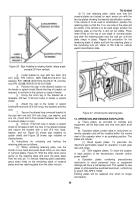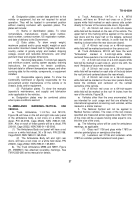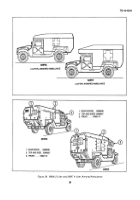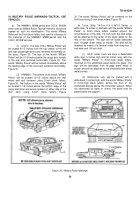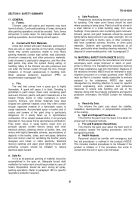TB-43-0209 - Page 39 of 406
TB 43-0209
e.
TB MED 514, Occupational and Environmental
Health Requirements for Painting Operations.
SECTION VI.
CAMOUFLAGING PROCEDURES
24. CAMOUFLAGE PATTERN PAINTING
a
.
This section covers methods of applying
Camouflage Paint Patterns (CPP) to Army material. It
also covers procedures for inspecting applied CPP.
Equipment consists mainly of brushes and guns; paints
consist of Chemical Agent Resistant Coatings (CARC),
such as those listed in Appendix B. The CARC topcoats
are suited for camouflage painting and protect military
material against visual and infrared detection and
chemical agent contamination. The CARC camouflage
topcoats are MIL-C-46168 and MIL-C-53039. The CARC
epoxy
primers
are
MIL-P-52192,
MIL-P-23377,
MIL-P-53022, and MIL-P-53030.
b
.
Information on specific finish systems and kinds
of paint to be used for various applications is contained
in Appendix B. Surface preparation is covered in
paragraph 27. Application techniques are covered in
paragraphs 30-32. For additional information on
camouflage, refer to the following publications:
AR 750-1
Army
Materiel
Maintenance
Management
FM 5-20
Camouflage
TM 5-200
Camouflage Materials
c.
Major items to be camouflage-painted are
weapons systems, vehicles, construction equipment, and
materials handling equipment. The painting procedures
described in this chapter do not apply to aircraft. Three-
color camouflage patterns are created for all combat,
combat support, and combat service support equipment
having an area greater than nine square feet on one or
more sides. New items of tactical equipment normally will
be CARC coated in a three-color camouflage pattern at
the factory or depot. Some items, however, may be
painted with lusterless CARC green 383 when the
pattern has not been developed, Items painted in CARC
green 383 or alkyd enamel will only be three-color
camouflage CARC coated when a complete repainting is
required for maintenance purposes.
d.
Only DS/GS Support and Depot level personnel
are authorized complete painting and repainting of
components with any topcoat or primer. DS/GS Direct
Support
personnel
are
authorized
complete
painting/repainting only if they use an OSHA approved
spray-paint booth. Unit level personnel are permitted to
use topcoats and primers for touchup efforts only. This
includes all CARC coatings.
25. REASON FOR PATTERN PAINTING
a.
All military vehicles and equipment have
characteristic shapes and shadows. These shapes and
shadows contrast with the material surroundings and
make the object stand out.
Pattern painting using wavy,
irregular patches of camouflage colors does much to
break up the characteristic shapes of the equipment by
reducing contrasts with sod and vegetation, pattern
shape, and placement. Patterns have been designed for
each type of vehicle to cut off sharp corners, avoid
straight, vertical, and horizontal lines, and extend
shadows in shapes similar to natural features and
vegetation; however, the accuracy with which the CPP is
applied completely determines how well the CPP
camouflages the equipment.
b.
Pattern painting is not a magic, cure-all
camouflage technique, but it makes the item much
harder to see and recognize as a military object. It also
provides an excellent base for applying further natural
camouflage such as tree limbs, shrubs and grass.
c.
The theory behind pattern design is to provide a
camouflage system for equipment that is universal and
can he adapted to various geographical, seasonal, and
terrain changes by the changing of one or possibly two
colors. For instance, temperate zone colors of green,
brown and black may be changed to desert colors by
changing green to tan.
NOTE
CARC colors should not be mixed with one
another as this will alter their individual
effectiveness when applied to the end item.
Blending is not permitted.
d.
These resigns also lend themselves to touchup
painting with better results than are now obtainable from
touchup of the current olive-drab vehicles. Slight
mismatches in color are expected at times and will not
be noticeable except upon close inspection. Likewise,
minor abrasions and scaling of surfaces will be equally
inconspicuous. Marring and surface lightening due to
handling is characteristic of camouflage coatings and
does not impede camouflage or infrared properties. This
is typical of low gloss and sheen coatings in dark colors
and is considered satisfactory.
26. PATTERN DESIGNS
See Figure 31, for example of the CPP for the
M113A1, Personnel Carrier. Within each area is a
number that stands for the color to be painted. There are
five views of the vehicle; front, back, left side, top, and
right side. Most designs will show these five views. The
base, or "primary" color is Color #2 and is usually applied
first over all surfaces. Color patches #1 and #3 a then
applied over the primary coating. The approximate
distribution, in percent, of the three colors is:
green--44
percent, black--41 percent, and brown--15 percent.
34
Back to Top



